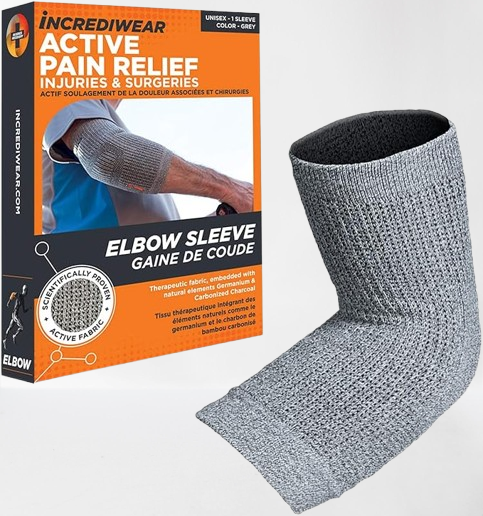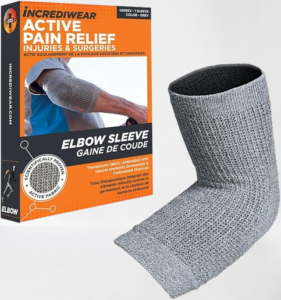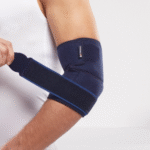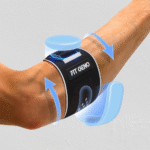Benefits of Using Best Elbow Compression Sleeves
Using the best elbow compression sleeves offers a wide range of benefits, especially for individuals dealing with elbow pain, inflammation, or injuries such as tennis elbow, golfer’s elbow, or arthritis. These sleeves are designed to provide gentle, consistent pressure and support to the elbow joint, promoting healing and comfort in both active and resting states.
1. Pain Relief and Inflammation Reduction
Elbow compression sleeves help reduce pain by applying targeted pressure that supports the muscles and tendons around the joint. This compression can minimize swelling and inflammation, making it ideal for conditions like tendonitis or after intense physical activity.
2. Enhanced Blood Circulation
The compression effect improves blood flow to the area, which is essential for faster healing. Increased circulation delivers more oxygen and nutrients to injured tissues, helping to reduce stiffness and speed up recovery.
3. Muscle and Joint Support
These sleeves provide stability to the elbow, reducing the risk of overextension or reinjury during activities like lifting, playing sports, or typing. They offer mild support without restricting your range of motion, which is great for staying active while managing pain.
4. Temperature Regulation
Most compression sleeves are made of breathable, moisture-wicking fabrics that help regulate temperature. This keeps the muscles warm during activity and prevents excessive sweating, enhancing comfort during prolonged wear.
5. Injury Prevention
Athletes and active individuals often wear elbow compression sleeves to prevent injury. By supporting the joint and reducing muscle vibration during movement, sleeves can help protect against strain and repetitive motion injuries.
6. Lightweight and Comfortable
Unlike bulky braces, elbow sleeves are lightweight and easy to wear under clothing. They offer discreet support throughout the day, whether you’re at work, the gym, or relaxing at home.
In summary, the best elbow compression sleeves offer a combination of pain relief, enhanced circulation, joint support, and comfort. They are a smart, non-invasive way to manage elbow issues and support your recovery or performance goals.
Importance of Using Best Elbow Compression Sleeves
Using the best elbow compression sleeves is highly important for individuals dealing with elbow pain, injury recovery, or even those looking to prevent strain during physical activities. These sleeves are more than just a supportive accessory—they play a key role in enhancing joint health, reducing discomfort, and improving performance.
1. Pain Relief and Inflammation Reduction
One of the main benefits of elbow compression sleeves is their ability to relieve pain and reduce inflammation. The gentle, consistent pressure applied to the elbow area improves blood circulation, which helps flush out inflammatory substances and speeds up healing. This makes them especially useful for conditions like tennis elbow, golfer’s elbow, bursitis, or arthritis.
2. Support During Physical Activity
For athletes or anyone performing repetitive arm motions, compression sleeves provide joint stability and muscle support. They reduce vibration and microtrauma to the muscles and tendons during movement, which can prevent overuse injuries. This is vital for sports like tennis, golf, weightlifting, or even jobs that require manual labor.
3. Enhanced Recovery
Wearing a high-quality elbow compression sleeve post-activity or after an injury promotes faster recovery. It reduces swelling, minimizes fatigue, and helps muscles return to their normal state more efficiently. This is particularly important during rehabilitation or physical therapy.
4. Comfort and Versatility
Modern compression sleeves are designed with breathable, moisture-wicking fabrics, making them comfortable for all-day wear. They are lightweight, discreet under clothing, and suitable for both everyday use and athletic performance.
5. Injury Prevention
Even if you’re not injured, wearing an elbow compression sleeve can help prevent future issues by maintaining proper alignment, warming up the joint, and providing additional support during stress-inducing tasks.
In summary, the best elbow compression sleeves offer a valuable combination of pain relief, support, recovery aid, and prevention. Whether you’re managing a chronic condition or staying proactive in your fitness routine, using a well-designed compression sleeve is a smart, effective way to protect your elbow health.
Types of Best Elbow Compression Sleeves
There are several types of elbow compression sleeves available, each designed to meet different needs—whether it’s for injury recovery, pain relief, athletic support, or chronic conditions. Understanding the types can help you choose the best one based on your lifestyle and goals.
1. Standard Elbow Compression Sleeves
These are the most common type, offering moderate, uniform compression around the elbow joint. They are ideal for general use, including mild pain relief, support during workouts, or prevention of overuse injuries.
2. Elbow Sleeves with Strap or Adjustable Band
These combine the benefits of compression with added targeted pressure, thanks to an integrated strap or band. This design helps relieve symptoms of tennis or golfer’s elbow by applying focused compression over the affected tendon area. Great for active individuals needing extra support during movement.
3. Copper-Infused Compression Sleeves
Infused with copper ions, these sleeves claim to offer antimicrobial properties and enhanced healing benefits. While scientific evidence is limited, many users report improved comfort and odor control with this type.
4. Neoprene Elbow Sleeves
These provide thermal insulation along with compression. They help retain body heat, which can soothe stiff joints and improve flexibility. Neoprene sleeves are often used in cold weather or for arthritis-related discomfort.
5. Athletic or Performance Sleeves
Specifically designed for sports and high-impact activities, these sleeves often feature extra padding, silicone grips, or breathable mesh zones. They offer enhanced stability and protection during intense workouts, weightlifting, or racket sports.
6. Medical-Grade Compression Sleeves
Recommended by healthcare professionals, these sleeves provide graduated compression and are often used post-surgery or for serious conditions. They are designed to reduce swelling, manage lymphedema, or promote healing after injuries.
Choosing the Right One:
The best elbow compression sleeve for you depends on your specific needs—be it pain relief, injury prevention, or athletic performance. Always consider factors like comfort, material, fit, and level of compression when making your choice.
Features of the Best Elbow Compression Sleeves
The best elbow compression sleeves are designed with specific features that maximize comfort, support, and effectiveness—whether you’re recovering from an injury, managing chronic pain, or boosting performance during workouts. Here are the key features to look for:
1. Graduated or Consistent Compression
A good sleeve should offer effective compression that improves blood circulation, reduces inflammation, and supports muscle recovery. Some sleeves offer graduated compression, which is tighter at the elbow and looser toward the upper and lower arm, enhancing circulation and reducing fatigue.
2. Breathable, Moisture-Wicking Material
Look for sleeves made from lightweight, breathable fabrics like nylon, spandex, or blends that wick away sweat. This keeps your arm cool, dry, and comfortable during extended wear or intense physical activity.
3. Ergonomic and Snug Fit
The sleeve should conform to the natural shape of your arm, providing a secure fit without slipping or causing restriction. Elastic cuffs or silicone grip lines help prevent it from rolling down or bunching during movement.
4. Durability and Quality Stitching
A high-quality compression sleeve will feature reinforced stitching and durable materials that can handle daily wear and repeated washing without losing shape or effectiveness.
5. Targeted Support Zones
Some advanced designs include reinforced or padded zones over the elbow joint or tendons for added support and protection—ideal for people with tennis elbow, golfer’s elbow, or arthritis.
6. Flexible and Lightweight Design
Mobility is key. A good sleeve should allow a full range of motion while still providing the compression and support you need. It shouldn’t feel bulky or restrictive.
7. Odor-Resistant and Hypoallergenic
Top-tier sleeves often include anti-odor or antimicrobial properties, such as copper or silver threading, and are made from skin-friendly materials to reduce irritation.
In short, the best elbow compression sleeves combine comfort, performance, and durability to deliver reliable support and help you stay active and pain-free.
How to Wear and Use Best Elbow Compression Sleeves Properly?
Wearing and using the best elbow compression sleeves properly is key to getting maximum support, comfort, and therapeutic benefits. Here’s a simple guide to help you wear your sleeve the right way:
🧩 1. Choose the Correct Size
Before anything, make sure the sleeve fits snugly but not too tight. A sleeve that’s too loose won’t provide effective compression, while one that’s too tight can restrict blood flow or cause discomfort. Most brands provide sizing charts based on bicep and forearm circumference—measure yourself accurately for the best fit.
🎯 2. Position the Sleeve Correctly
Slide the sleeve up your arm so that the center or thickest part rests over your elbow joint. If the sleeve has built-in support zones or padding, align them directly over the elbow for targeted relief. Make sure there are no wrinkles or folds, as these can cause pressure points or irritation.
🕒 3. Wear It During the Right Times
- During Activity: Wear the sleeve during workouts, sports, or repetitive tasks (like typing or lifting) to support the joint and prevent strain.
- Post-Activity/Recovery: It can also be worn after exercise or throughout the day to help reduce swelling and support muscle recovery.
- Avoid Overnight Use unless recommended by a healthcare professional.
🧼 4. Keep It Clean
Wash your sleeve regularly according to the manufacturer’s instructions (usually hand wash or gentle cycle). Clean sleeves prevent skin irritation and maintain breathability.
🧍♂️ 5. Monitor for Discomfort
If you feel tingling, numbness, or restricted movement, the sleeve might be too tight or incorrectly positioned. Adjust as needed or switch sizes.
✅ 6. Combine with Other Therapies (If Needed)
Use it along with stretching, rest, icing, or physical therapy for better results—especially if you’re managing an injury like tennis elbow or arthritis.
When used properly, elbow compression sleeves can provide daily support, reduce pain, and help you stay active and injury-free.
Top Pick
How to care for an Best Elbow Compression Sleeves?
Caring for the best elbow compression sleeves properly ensures they remain effective, clean, and comfortable for long-term use. Regular maintenance helps preserve their elasticity, support, and hygiene. Here’s how to take care of your elbow compression sleeves the right way:
🧼 1. Wash Regularly
Elbow sleeves absorb sweat, skin oils, and bacteria, especially during workouts or extended wear. Washing them after every few uses is essential.
- Hand Wash Recommended: Use mild detergent and lukewarm water to gently clean the sleeve.
- Machine Wash (if allowed): Place the sleeve in a mesh laundry bag to protect it, and use a gentle cycle with cold water. Always check the care label first.
- Avoid Harsh Chemicals: Skip bleach and fabric softeners, as they can break down the elastic fibers.
🌬️ 2. Air Dry Only
Never use a dryer, as high heat can damage the material and reduce elasticity. Instead:
- Gently squeeze out excess water without wringing it.
- Lay it flat or hang it in a shaded, well-ventilated area to air dry.
- Avoid direct sunlight or radiators, which can warp or shrink the fabric.
🔍 3. Inspect for Wear and Tear
Check your sleeve regularly for signs of looseness, thinning fabric, or fraying seams. If the sleeve no longer fits snugly or loses compression, it’s time to replace it.
🧺 4. Store Properly
When not in use, store your compression sleeve in a cool, dry place away from direct sunlight or moisture. Avoid folding it tightly, which could damage the material over time.
🚫 5. Don’t Share Your Sleeve
For hygiene and fit purposes, avoid sharing your sleeve with others. It’s tailored to your arm’s shape and support needs.
By following these simple care tips, your elbow compression sleeve will stay in top condition—delivering the support, comfort, and performance you rely on.
What is the best Best Elbow Compression Sleeves company?
1. Incrediwear
Incrediwear elbow sleeves are highly praised for their innovative fabric technology that promotes blood flow and reduces inflammation. They are great for managing chronic pain, arthritis, and sports-related injuries without relying on heavy compression alone.
2. Bauerfeind
A premium German brand, Bauerfeind offers elbow sleeves that provide medical-grade compression and anatomical support. Their sleeves are ideal for conditions like tennis elbow and golfer’s elbow, offering both therapeutic benefits and all-day comfort.
3. Iron Bull Strength
Perfect for weightlifters and athletes, Iron Bull sleeves offer strong compression and stability using thick neoprene material. They’re built for intense workouts and help prevent joint fatigue and injuries during heavy lifting.
4. Zensah
Zensah is known for its lightweight, breathable, and moisture-wicking sleeves. Their products are great for athletes and active individuals seeking moderate support during running, cycling, or fitness training.
5. McDavid
McDavid combines compression with targeted joint support and flexibility. Their sleeves are designed for both performance and recovery, helping reduce pain from overuse or minor elbow injuries during sports or workouts.
Each of these brands excels in different areas—whether it’s sports performance, recovery, or long-term pain relief. The best option depends on your personal needs, such as the level of support, comfort, material preference, and intended activity.






















